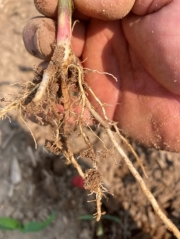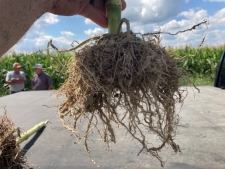Westfield, Indiana, USA
May 20, 2024
 AgriGold Agronomist Steven Heightchew says the shovel is one of the most important tools for evaluating crops.
AgriGold Agronomist Steven Heightchew says the shovel is one of the most important tools for evaluating crops.
Want an early read on your corn crop’s potential? Pull out the shovel, advises AgriGold Agronomist Steven Heightchew. “The root system is the most important part of a corn crop, but also the most overlooked.”
Root development can guide management decisions. “Evaluating corn as it’s emerging gives farmers a scorecard for the rest of the year, showing whether they can push the crop to its maximum potential or whether the groundwork is laid for an average crop,” Heightchew explains.

To assess crop prospects and plan for seasons to come, farmers should look below the surface to the root system.
Root dig at emergence
“When I get called to a field to look at unevenness, it usually has to do with the radicle root system being injured by pests or chemicals,” Heightchew says. Even when there’s not a problem, he says it’s important to dig up plants and see how radicle roots are faring.
To get things off to a solid start, Heightchew says, “we need the right root growth, the proper seeding depth, the crown to set at three-quarters of an inch and those roots to come out at 45-degree angles.”
To assess root systems, farmers should find a few representative places in their fields to dig up some plants. If there’s a lot of variation in your ground, you may need to do separate evaluations of those areas, Heightchew says.
Farmers should use a hand shovel to gently dig up the corn as it’s spiking through the ground, making sure to scoop out the entire root ball and seed. That provides what they need to evaluate whether there were any issues with the planter pass, like sidewall compaction or shearing, as well as to determine if there has been chemical or pest injury to the plant’s root system.

For the corn factory to thrive, it needs to have big, deep roots to pull up water and nutrients.
Check roots again at V3/V4
The next time Heightchew recommends farmers pull out the shovel is in the V3/V4 time frame when the seedling is around a foot tall and shifting from its seminal root system to its nodal root system for nutrient uptake.
“The fibrous roots should start at that 45-degree angle and branch down through the soil to get the depth needed for water uptake if dry conditions develop,” Heightchew explains. “For the corn factory to thrive, it needs to have big, deep roots to pull up water and nutrients.
“Think of those roots like a straw in a milkshake,” Heightchew says. “With a small straw, you’ll have trouble pulling the milkshake up out of that cup. But if you use a bigger straw, it’s easier.”
If there’s adequate soil moisture, a good 45-degree root set and no compaction, Heightchew says that’s the green light farmers need to apply additional inputs and push yields.
But if roots start turning to go out rather than down at that 45-degree angle at the 3- or 4-inch mark, that indicates you have compaction lower in the soil — likely due to tillage. “When that happens, farmers should focus on having nutrients available in those top 3 to 4 inches,” Heightchew says. Water availability will also be key.
Roots can guide troubleshooting in the fall
If yield estimates disappoint come fall, the first thing farmers should do is dig, Heightchew says. “Even that far into the crop cycle, you can usually pinpoint what went wrong by looking at the roots.”
Besides a shovel, Heightchew wants farmers equipped with a penetrometer, noting a sharpened piece of rebar also works. “You just need something you can push down into the soil to see if there are restrictions. If it pushes through the soil easily, that’s good. But if you face resistance, so will roots.” In the latter scenario, he says farmers should work on soil health and evaluate magnesium levels.
It's easy to get in a hurry in the spring, rushing to plant ahead of rain or to push planting early in hopes of capturing that yield advantage. “Rooting starts with the planter pass. Taking the time to make smart decisions and place seed right, that will give you better yields overall,” he says. “Balance is the key.”
Want support striking that balance? Reach out to your local AgriGold agronomist for help monitoring crops through the growing season.
ABOUT AGRIGOLD
AgriGold offers high-performing hybrids paired with the latest agronomic knowledge and data to achieve exceptional crop performance, year after year. Based in Westfield, Indiana, AgriGold is for the farmer who wants a true seed partner that is an ally in the field. For more information, visit AgriGold.com and follow us on Facebook, Instagram, LinkedIn and X, formerly known as Twitter.
ABOUT AGRELIANT GENETICS
AgReliant Genetics is committed to providing trusted seed solutions that help farmers grow. We do this by focusing solely on seed and delivering one-of-a-kind, high-performing hybrids. Founded in 2000 by global seed companies KWS and Limagrain, AgReliant Genetics benefits from direct access to a global corn germplasm pool and has a top four corn research program. Through our seed brands — AgriGold® and LG Seeds in the U.S. and PRIDE® Seeds in Canada — we proudly offer the latest innovation to our farmer customers, whether they grow corn, soybeans, sorghum or alfalfa. Discover more at AgReliantGenetics.com.